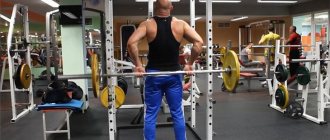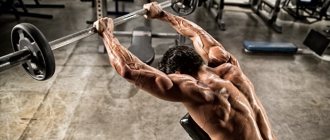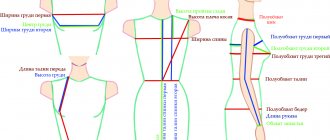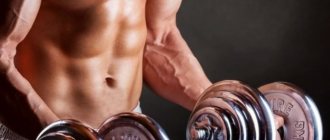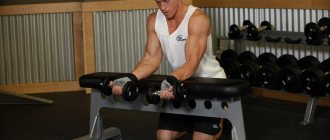Our deltoids (or shoulders) are an integral part of our body. Thanks to them we can move our arms freely. They also help our body push, pull and lift. Therefore, it is very important to take care of your shoulders and keep them as strong as possible.
If we neglect our deltoids, then one day (with the advent of progress) we will find that we do not have enough strength to perform pushing, pulling and lifting exercises. For this reason, it is important to do separate delt training to sufficiently develop shoulder strength and power.
Often men ignore delt training, except for people who know its importance. By reading this article, we think you're one of the lucky few who already knows the basics of how your shoulders should move and be strong. The following material discusses various delt training methods that you can try, both in the gym and in the comfort of your home.
Overhead press
The overhead press works most of the body, including the deltoids. Exercise helps strengthen muscles and also increases their mass. Additionally, it addresses other weaknesses associated with upper body strength and allows you to do more reps in the future on other exercises that were previously difficult for you.
- Place the barbell in a rack that is just above the level of your deltoids. Stand with your feet shoulder-width apart and engage your core;
- Lift the barbell up, pushing overhead and squeezing your shoulder blades;
- Carefully lower the bar;
- Repeat.
Approaches: 1-2.
Reps: 8-10.
Rest: superset.
Archer's Kneeling Row
Typically the kneeling archer row exercise is a floor warm-up, but it's also ideal for any shoulder workout you have planned. During execution, the chest is worked with simultaneous external rotation of the shoulders of both arms.
- Lower your left knee to the ground and grasp the ends of the resistance band with your hands. Breathe and engage your core;
- Raise your arm slightly over your shoulder and look at it, tensing your back muscles. Make sure you keep your right arm straight;
- Bring your left hand to your right elbow as if drawing a bow and arrow. While performing this part, squeeze your back muscles and tense your shoulders;
- Return to starting position and repeat.
Approaches: 3.
Reps: 12.
Rest: 1 minute between sets.
Arnold press
If you want to get as big as Arnold Schwarzenegger, consider adding the Arnold Press to your delt workouts. This exercise is named after the famous politician, actor and, of course, the coolest bodybuilder!
- Hold dumbbells in each hand at shoulder level. Make sure your elbows are bent and your palms are facing your body;
- In one smooth motion, spread your elbows out to the sides, turning your hands palms forward;
- Press the dumbbells overhead. Arms should be straight and biceps at ear level;
- Stay in this position for a while and return to the starting position;
- Repeat.
Approaches: 3.
Reps: 10-15.
Rest: 1 minute between sets.
Front lift
The front raise is a beginner exercise that targets the anterior deltoid muscle, which is used in shoulder flexion. The exercise strengthens the shoulders and also works the chest, additionally drawing out the deltoids in the front and sides.
- Place your feet shoulder-width apart. Straighten your back and keep it straight throughout the entire exercise;
- Hold a dumbbell in each hand and let it hang down;
- Tighten your abs;
- Raise the dumbbells as you inhale, keeping your arms forward with your palms facing down. You can keep your elbows slightly bent to reduce stress on your joints;
- Stop lifting when the dumbbells reach shoulder level and are parallel to the floor;
- Slowly return the dumbbells to the starting position as you exhale;
- Repeat.
Approaches: 1-3.
Reps: 10-12.
Rest: 1 minute between sets.
Anatomy of deltas
To understand how to build big shoulders, you need to understand how they work. The deltoid muscles completely surround the shoulder joint, partially covering the shoulder muscles and extend to the humerus, where they are attached to the upper part of it. It consists of three bundles:
- Front bun. It originates from the anterior edge of the clavicle. Responsible for raising your arms in front of you, as well as for moving your elbows toward your body.
- The middle bundle is attached to the top of the shoulder blade. The task is to raise your arms to the sides.
- The posterior bundle starts from the posterior edge of the scapula. Pulls his hands back.
Working together, all three muscle bundles allow for a wide range of movements, making the shoulder joint the most mobile joint in our body. By fully contracting, the delta can move our shoulder forward and backward, down or up.
Bent-over dumbbell lateral raises
The bent over dumbbell lateral raise helps the shoulder muscles by targeting the posterior deltoid, the back of the shoulders. This exercise additionally works some of the larger back muscles. It is an excellent addition to delt training. You can do it standing or sitting.
- Hold a dumbbell in each hand;
- To perform, bend down until your upper body is in line with the floor. Do not take your eyes off the floor, while your knees should be slightly bent, your back straight, and your chest straight;
- Keep your elbows straight, but not tense, and let the dumbbells face your palms towards each other;
- Raise both dumbbells up and out to the sides until your arms are parallel to the floor and approximately level with your shoulders;
- Slowly return the dumbbells to the starting position and repeat.
Approaches: 1-3.
Reps: 8-10.
Rest: 1 minute between sets.
Reasons for development
- Often, shoulder disease develops against the background of cervical osteochondrosis, when degenerative-dystrophic changes smoothly flow below.
- Often the cause is injury, especially among those who regularly perform the same type of movements as part of their professional activities (painters, builders, tennis players, boxers, etc.).
- Hormonal changes during menopause also lead to pathological processes in the joints.
- Sometimes the disease occurs against the background of metabolic disorders due to obesity or diabetes.
- In some cases, pathology is formed due to malfunctions of the gallbladder, liver, due to varicose veins, or against the background of any inflammatory process in the body.
To prevent the disease from reoccurring, it is important to determine its true cause at the start.
Standing barbell shrugs
Barbell shrugs primarily target your trapezius muscles, the muscles in your upper back. However, this does not mean that this delt exercise does not work for your delts at all. So, if you want to make your delts more resilient, this is an exercise you should add to your shoulder day routine.
- Stand straight, feet shoulder-width apart;
- Bend your knees, place your hands close to your hips, and hold the barbell with an overhand grip. Raise the barbell to waist level;
- Raise your shoulders up, as if you were shrugging, and hold the barbell at the top for 1-2 seconds;
- Lower the bar to its original position;
- Repeat.
Approaches: 1-3.
Reps: 8-10.
Rest: 1 minute between sets.
Subacromial impingement
Primary impingement syndrome
Repeated compression of the rotator cuff tendon and bursa between the shoulder and the acromion and/or coracoacromial ligament can lead to irritation and inflammation. When the rotator cuff tendon and/or bursa become inflamed, the subacromial space is further reduced, the tendon and bursa typically become compressed (pinched) in the subacromial space, and the condition is called subacromial impingement (16). People with primary impingement typically experience pain when lifting the affected arm (especially above shoulder level), due to pressure from the inflamed and irritated rotator cuff tendons and bursa. To prevent the onset or worsening of the primary impingement, several weight-bearing exercises may need to be modified.
Shoulder abductions are an excellent exercise for strengthening the medial deltoid and supraspinatus muscles. Typically, abductions are performed with the palms facing down (internal rotation at the shoulder joint), which leads to impingement of the rotator cuff (Figure 5). When the arm is raised, the rotator cuff tendons normally move with minimal pressure on the overlying acromion. However, when the arm rotates inward at the same time as it lifts, the greater tuberosity of the shoulder compresses the rotator cuff tendons and bursa against the acromion (8). Repeated compression leads to inflammation and damage to the rotator cuff tendons or bursa (16). To reduce the pressure as much as possible, you need to raise your arm with external rotation of the shoulder. Clients are encouraged to use a neutral grip with thumbs pointing toward the ceiling to externally rotate the shoulder (Figure 6). It is necessary to exclude the seated shoulder abduction machine, which requires internal rotation when lifting (Figure 5). It can be replaced with abductions with external rotation, with dumbbells.
Another exercise that leads to subacromial impingement is the chin row. When performing a chin-up, the arms are maintained in an internal rotation position throughout the lift. We recommend eliminating this exercise entirely or limiting the lift to 800 and not raising your elbows higher than your shoulder joints to prevent rotator cuff impingement.
Subacromial impingement is exacerbated by excessive flexion exercises (16). A pullover with free weights lying on your back (Figure 7) or in a machine presses the rotator cuff tendon and bursa to the acromion in the position of maximum flexion of the arms. This exercise can be performed more safely by simply limiting the flexion to normal physiological ranges or a comfortable range of motion. As an alternative for the latissimus muscles, you can offer straight arm extension while standing at the top block.
Figure 5. Seated shoulder abductions with shoulder inward rotation.
Figure 6. Abduction in the plane of the scapula (300 anterior to the frontal plane of the body).
Secondary impingement syndrome
Exercises that promote hyperelasticity of the anterior shoulder capsule (discussed above) also contribute to the development of secondary rotator cuff impingement syndrome (10, 12). If the arms do not remain centered in the shallow glenoid fossa of the scapula when moving, the rotator cuff tendons and bursa become re-compressed and inflamed. Additionally, the rotator cuff muscles have to work harder to regain stability and become prone to fatigue, tendinitis (microtrauma), inflammation and subsequent impingement. Because impingement develops secondary to hyperelasticity and instability, this condition is called secondary impingement (10, 12). In case of a secondary impact, it is advisable to avoid loading the anterior capsule stops, excluding exercises that combine external rotation of the arm with horizontal abduction. Therefore, modifications to the exercises prescribed for people with secondary impingement need to be made, as for anterior instability or hyperelasticity of the shoulder joint.
Figure 7. Pullover on the back.
Internal impingement syndrome
In a dangerous position in the shoulder joint, an internal collision of the articular part of the supraspinatus and infraspinatus tendon with the posterior part of the labrum may occur (Figure 1; 3, 9). Internal impingement most commonly occurs in throwing athletes due to repeated external rotation of the shoulder combined with abduction and horizontal abduction, which impinges the tendon against the labrum. Anterior shoulder instability is a predisposing factor to the development of internal impingement (2, 10). It is wise to avoid exercises that cause impingement pain in the posterior joint (not muscle soreness) and/or aggravate anterior instability. It is recommended to perform exercises in safe positions.
Figure 8. Stand with bent legs (left).
Figure 9. External rotation of the shoulder on a block with abduction to 90 0
(right).
Pull the tape to the face
The facelift targets the rear deltoid muscles. The exercise also helps your diamond back and middle trapezius. Both of these muscles are directly related to shoulder movements.
- Hang the resistance band on a wall bar that is high enough to perform the exercise;
- With your palms facing inward, hold each side of the tape with one hand;
- Squeezing your shoulder blades together, slowly pull the bands toward your deltoids;
- Hold the position for a few seconds and return to the starting point;
- Repeat.
Approaches: 3.
Reps: 8-10.
Rest: 1 minute between sets.
Common Mistakes
There are a number of reasons why the shoulders may not grow, and only the muscles of the chest and arms begin to grow.
The delta is a very capricious muscle that requires only targeted training.
The most common mistakes are:
- The load is placed on the wrong groups of bundles and muscles in general. As a rule, the front delta does most of the work, while the middle and rear deltas remain out of work. Therefore, it is very important to follow the correct technique.
- Lack of basic exercises, when a person without preparation wants to immediately work his shoulders, without first training his arms.
- Weights that are too light or heavy. A sign of correctly selected weight of the projectile is that 15-20 repetitions can be done without noticeable load, the rest is done through force. It is the last 10 times that strengthen the deltas.
- No progress in reps or weight. If the load does not increase, the muscles get used to it and stop growing.
- You do not feel the contraction of the rear deltoid. This is the main sign of incorrect execution of the exercise.
It is also very important to eat well and get all the necessary vitamins. An athlete should drink a minimum of 2.7-3 liters of water per day.
Barbell row to the chin
The exercise, the barbell row to the chin, involves the main muscle groups, as well as the hamstrings and back, more precisely the trapezius. If you want to fully work your delts, this is the exercise for you. The barbell chin row puts enough stress on your shoulders, causing powerful muscle growth, improving your size and posture.
- With your hands shoulder-width apart and palms facing down, grab the barbell bar and place it in front of your hips;
- Bend your knees and waist. The bar should be slightly above the knees;
- In a smooth motion, extend your hips as if you are about to jump and pull the barbell high to shoulder height. Make sure your elbows are wide apart;
- Hold for a couple of seconds before returning to the starting position;
- Repeat.
Approaches: 1.
Reps: 8-10.
Rest: superset.
Useful tips
When working on the shoulder muscles, you must follow the following recommendations:
- Have barbells and dumbbells for training. Their weight depends on physiological capabilities. You should select options to allow you to do 10 or more repetitions. For 1 workout, 5 to 10 sets should be performed. A woman is not recommended to lift more than 5 kg. If the goal is to pump up your shoulders, making them wider and more massive, then you can take heavier weights. If the main goal is to reduce the shoulders and narrow the back, then the weight is minimal. The emphasis should be on increasing the number of approaches.
- Increase study periods little by little. Women have average muscle mass and injuries may occur with sudden exertion.
- Remember about the risk of getting a sprain, so strictly follow the technology even if you are in good physical shape.
- First, the technique must be carefully worked out without dumbbells and barbells, and then move on to movements with minimal weight.
- Don't forget about warming up. It is required before every workout.
- Don't be afraid of muscle pain at first. This is normal: pain indicates that you have received the required load. A warm salt bath with lavender oil will help eliminate it. After the bath, you need to thoroughly rub your muscles.
- To noticeably increase your shoulders, it is better to work with heavy weights.
- The best number of repetitions is 8-12 times. The final 2 repetitions should be performed with all your might.
- You should not overload your body with training.
Standing dumbbell lateral raises
Dumbbell lateral raises help make the deltoids stronger. They absorb any negative impacts directed at the shoulders. Reduce the risk of possible injuries to the neck and deltas.
- Hold a dumbbell in each hand;
- Let the dumbbells hang on each side with your palms facing inward;
- Retract your shoulder blades and lift the dumbbells straight out to the sides. Your arms should become parallel to the floor;
- Hold this position for a couple of seconds before returning to the starting position;
- Repeat.
Approaches: 3.
Reps: 8-10.
Rest: 1 minute between sets.
Seated dumbbell press
Shoulder Press Workout
The seated dumbbell press is one delt workout you should never cross off your shoulder day list. The exercise targets the entire deltoid muscle group. We can say that this in itself is a complete exercise for the deltoids.
- Sit on a straight bench;
- Hold a dumbbell in each hand. Raise both dumbbells at shoulder level with your palms facing forward;
- Keeping your spine and head straight, lift the dumbbells over your head, close to each other. Make sure they are close to each other but not touching;
- Keep your arms straight and hold the position for 2-3 seconds;
- Slowly return to the starting position;
- Repeat.
Approaches: 3.
Reps: 8-10.
Rest: 1 minute between sets.
Shoulder Training Frequently Asked Questions
How often should I train my delts?
If you ask fitness gurus and enthusiasts how often they train their shoulders, you will get different answers. However, the recommended frequency for shoulder training is 2-3 times per week with at least one day of rest between workouts. Start your program with light or medium weights and gradually increase the duration and intensity. This is necessary to prevent injury.
Is it possible to increase the shoulder size?
Yes! You can definitely increase your shoulder size with the right combination of exercises. The best exercises to help increase delt strength are exercises that focus on the deltoid muscles. However, you still need to maintain balance in your body and perform various full-range exercises. Meanwhile, recommended exercises that will help increase shoulder size are barbell shrugs, face rows, bent-over lateral raises, and front raises, among many others.
Reps and weights
Unlike most muscles, the delta requires increased load not in weight, but in the number of repetitions.
It must work hard for a visible effect to appear. Minimum number of each set of exercises: 30-35 times during the entire workout.
It is better to do three sets, ideally four. The weight should be light so that it can be comfortably lifted many dozens of times without breaks or respite.
Periodically, you can practice with heavy weights that you cannot lift more than five times.
But such training should be very rare - no more than once a month.
It is better to train the rear deltas on a separate day in order to fully “load” it.
In total, it may take about three to four months for muscle mass to noticeably increase and the relief to acquire more expressive outlines.
